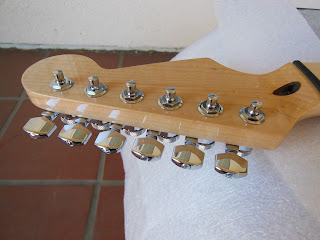I decided early on that I wanted this guitar to be a workhorse, and I decided on Schaller locking tuners. The locking tuners can help to keep the strings in tune if the tremolo's going to be used heavily. For me, I decided on the tuners because of the tuning ratio (1:16). This means that for every 16 turns of the peg, the head turns once. Other tuners that I had considered were 1:14 or lower ratios, making tuning a lot less accurate.
The first order of business was to get all of the parts that I'd need together. The particular mounting type of the machine heads required holes for the pins to be drilled first (the traditional way used screws, which required test fitting the parts first and then marking and drilling).
Here are two pictures of a tuning machine looking at the side which would be mounted to the headstock. The pin is pretty obvious, being the little nub to the right of the main tuning machine barrel.
Gathering all the parts required. Counterclockwise from top: the neck, masking tape for protecting the finish, 12 inch straight edge, drill jig, 6 inch straight edge, clamps, #38 drill bit, countersink bit, tuners, digital caliper.
I then proceeded to measure the depth of the drill jig and the pin on the tuning machine itself.
The result was 12.48 mm for the drill jig depth and 4.08 mm for the pin, resulting in 16.56 mm total for the drill bit (this degree of accuracy would end up not being relevant, but more on that later). The instructions for the drill jig stated that the correct drill depth would be 11/16 inch, which is 17.4625 mm, but I decided to go with the conservative route and set the drill depth to be 16.56 mm.
Next, I had to make sure the jig would be squared on the headstock. My solution was to use the 2 straight edges and produce 2 parallel edges for squaring the jig.
I first placed masking tape around the neck to provide a cushion upon which the straight edges could be clamped:
I also taped the locations where the drill hole would be, because I wanted to be extra careful with the finish. Drilling bare into finish is a great way to chip or crack it, so I wanted to be as careful as possible (that didn't end up being required since the drill jig pressure on top of the finish was enough to keep it safe).
Straight edges clamped on and guiding the jig:
Once I was ready to drill, I went ahead and cautiously drilled through the masking tape, being careful to do a couple of passes and making sure to back out the drill properly and often to clear out the wood chips.
The first drill hole:
The drill jig ended up being really accurate... too accurate in fact, as I ended up having to freehand, but more on this in a bit...
All the drill holes done!
I was pretty happy when all the holes were complete, but when it came time to install the tuners, I found that they weren't mounting flush. I ended up using the deeper 11/16 inch drill depth as instructed by the drill jig documentation, but I found that there was still something wrong.
As it turns out, the drill jig was so damn accurate, with absolutely no free play for the tuning machine pin fit, that the inaccuracy of the tuner holes for the barrel caused the pins to not fit properly!
I ended up trying to redrill the holes with the jig and with the straightedges removed, but there wasn't even enough free play in the jig to slightly elongate the holes. I tried countersinking the holes, but that didn't work either.
In the end, I finally decided to elongate the holes freehand using the existing holes as a guide, and that finally got the barrel-pin distance right for a couple of the holes that had problems. Sometimes, being too accurate when the rest of the pieces aren't can cause problems.
Once the pin holes were right, I installed the tuners, and it was a simple task just tightening the nuts with a 10 mm socket.
The finished installation:
Shiny!
You can see the 3 + 3 staggered heights of the string holes. The 3 tuners on the left have lower string hole placement while the 3 tuners on the right have heigher string hole placement. This is to help keep the angle of the strings from nut to tuner consistent, for consistent tension of the strings over the nut.
Late afternoon sunlight and the headstock.
Looks great, but did I mount it straight?
Looks promising...
That's about as good as it gets!
Aw yiss!
Now that the tuners are in, I have to deal with the two most critical pieces: fitting the neck to the body, and installing the tremolo.
But for now, I deserve a nice cold soda.






















No comments:
Post a Comment